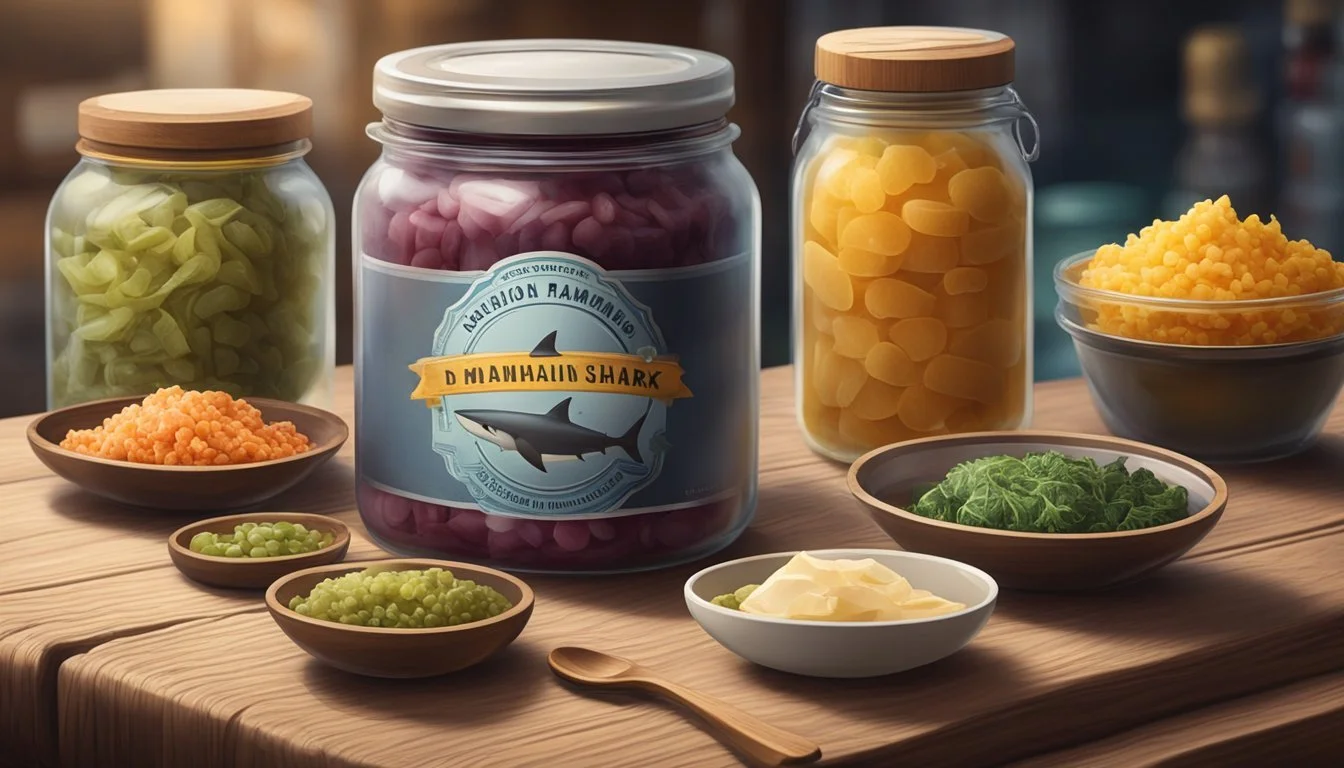Pickled Shark
Delving into the Traditional Icelandic Dish Kæstur Hákarl
Kæstur Hákarl, widely recognized as hákarl, stands as a quintessential Icelandic dish with deep roots in the nation's culinary tradition. It's made from the meat of Greenland shark or other sleeper sharks, which undergoes a distinctive fermentation process and is then hung to dry for several months. The dish is noted for its strong ammonia scent and a taste that can be quite challenging for those unaccustomed to its unique qualities. Despite its pungent aroma and acquired flavor, hákarl holds a celebrated spot in Icelandic culture, symbolizing the hardiness and ingenuity of its people in using available resources.
The process of creating hákarl involves a precise fermentation technique that has been perfected over centuries as a means of preservation in the harsh Icelandic environment. The meat is first cured and then left to ferment in a controlled environment before the drying stage, which contributes to its distinctive taste. It's typically consumed in small bites and is often accompanied by a shot of Brennivín, a traditional Icelandic spirit, which complements the strong flavor of the shark meat.
As a traditional Icelandic food, hákarl is linked with various cultural festivities, including the midwinter festival known as Þorrablót. This dish not only reflects Iceland's gastronomic history but also serves as a testament to the local commitment to maintaining and celebrating their ancestral culinary practices. While hákarl can be polarizing among food enthusiasts, it remains an emblematic delicacy that ignites curiosity and respect for Iceland's culinary heritage.
Historical Background
Kæstur Hákarl, an Icelandic delicacy, carries a rich historical background deeply entwined with the nation's Viking heritage and has sustained its cultural significance through the ages, often celebrated during festivals like þorrablót.
Viking Origins
The origins of Kæstur Hákarl are believed to trace back to the Viking Age, a time when preserving food was crucial for survival. The Vikings of Iceland developed a method of fermenting shark meat — possibly out of necessity — which turned toxic flesh into an edible food source. This tradition has prevailed through the centuries, reflecting Iceland's ability to adapt and its resilience.
Cultural Significance
Kæstur Hákarl is more than food; it is a testament to Iceland's culinary heritage. Traditionally enjoyed during the midwinter festival of þorrablót, a celebration of pagan origins, hákarl is often accompanied with Icelandic schnapps. It serves as a connection to a past where food played a significant role in gatherings and rituals, symbolizing the enduring spirit of Icelandic culture.
Modern Perception
For Icelanders, hákarl remains a point of national pride; for tourists, it is an acquired taste often explored on cultural food tours. Celebrated figures like Anthony Bourdain and Gordon Ramsay have brought international attention to this dish, albeit with critical reviews of its pungent aroma and unique flavor profile. Despite mixed reactions, hákarl has a central place in the fabric of Icelandic cuisine.
Museums and Attractions
Interest in hákarl has led to the establishment of attractions like the Bjarnarhöfn Shark Museum, where visitors can gain insight into the preparation of this national dish. Additionally, establishments such as Café Loki offer hákarl, making it accessible for locals and visitors alike. The item is a staple in Icelandic stores, often featured as part of the culinary exploration for those visiting the island.
What is Kæstur Hákarl?
Kæstur Hákarl is an Icelandic delicacy with a strong presence in cultural tradition, known for its pungent ammonia-rich smell and a distinctive fermentation process. It is made from the meat of the Greenland shark, which is naturally toxic if consumed fresh. Through fermentation, the shark meat becomes edible and forms an integral part of Icelandic cuisine.
Understanding Fermentation
Fermentation Process: The Greenland shark's meat, containing high levels of urea and trimethylamine oxide, is toxic when fresh. To neutralize these toxins, the meat undergoes a fermentation process. The shark is beheaded, gutted, and placed in a shallow grave covered with sand and stones. It ferments for 6-12 weeks, after which it is hung to dry for several months. The resulting chemical changes make the meat safe for consumption.
Differentiating Hákarl
Types of Hákarl: There are two main variants of hákarl: glerhákarl (from the shark's body) and skyrhákarl (from the belly). Glerhákarl is considered to have a milder flavor compared to the stronger skyrhákarl.
Comparison with Other Foods
Similar Foods:
Lutefisk: Lye-cured fish, less pungent than hákarl.
Rakfisk: Fermented freshwater fish from Norway, also with a strong smell.
Surströmming: Swedish fermented herring, known for its strong odor.
Svið: Singed sheep's head, another traditional Icelandic dish, not fermented but with a unique taste.
Hangikjöt: Smoked lamb, without the strong smell associated with hákarl, but similarly iconic in Iceland.
Cheese Comparison: The aroma of hákarl can be compared to a strong cheese, such as blue cheese, which has an assertive scent and taste.
Serving and Consumption
Pairing with Brennivín: Traditionally, hákarl is served with a shot of Brennivín, an Icelandic spirit that complements its strong taste. Þorramatur: Typically consumed during the midwinter festival Þorrablót, hákarl is part of the Þorramatur, a selection of traditional Icelandic dishes. It is often eaten in small cubes or strips.
The experience of consuming hákarl is distinctly robust, influenced by its preparation process and historic roots in survival, symbolizing a connection to the Icelandic heritage.
Preparation and Safety
Kæstur Hákarl, a dish made from fermented Greenland shark, requires careful handling during preparation due to shark's naturally high levels of urea and trimethylamine oxide, which can be toxic. This section details the essential preparation steps and safety measures necessary to transform the toxic flesh of one of the longest-living vertebrates into a safe, traditional Icelandic delicacy.
Traditional Methods
The traditional preparation of Hákarl involves a fermentation process that breaks down the harmful substances in the shark meat. The Greenland shark's flesh is first gutted and beheaded, and the crucial step of fermentation begins:
The meat is buried in a shallow grave covered with sand and gravel.
Heavy stones are placed on top to press out fluids that contain toxins like urea and trimethylamine oxide.
The flesh is left to ferment for 6-12 weeks, depending on the season.
After fermentation:
The shark is dug up and cut into strips.
It is then hung to dry for several months.
The result is Hákarl, with its distinctive ammoniac smell and fishy taste.
Contemporary Techniques
While modern techniques still respect traditional methods, contemporary practice often involves regulated environments to ensure consistent safety and quality of the fermented shark. The process includes:
Indoor fermentation in controlled conditions to replicate the effect of the traditional burial.
Monitoring of temperature and humidity during the drying phase.
Commercial producers may also use specialized facilities to perform these steps, ensuring that the shark meat is safe for consumption while adhering to health and safety regulations.
Health Considerations
To ensure health safety of the final product, strict procedures are adhered to throughout the preparation process. This diligence is necessary because Greenland shark meat is naturally toxic if consumed raw due to high levels of urea and trimethylamine oxide. The fermentation and drying process not only renders the meat safe to eat but also contributes to its unique flavor.
Consumers should still be aware of the potent odor and strong taste of Hákarl, which can be off-putting to those unaccustomed to it. While the final product is considered safe for consumption, individuals with a sensitivity to strong flavors may wish to proceed with caution.
Culinary Experience
Kæstur Hákarl is an Icelandic delicacy that offers a unique taste profile and an intense olfactory experience. It is notable for its stark aroma and a flavor that often invokes a strong reaction.
Taste and Smell
Kæstur hákarl is characterized by its strong flavor and ammonia-rich smell, which can be overwhelming for the uninitiated. The meat of the Greenland shark, once fermented, produces a sharp, pungent scent reminiscent of cleaning products due to the high levels of urea that transform into ammonia during the fermentation process. This smell is an integral part of the overall sensory experience.
First-Time Tasters
First-time tasters, including tourists and even culinary explorers like Anthony Bourdain, James May, and Neil Oliver, have had varied reactions to hákarl, ranging from appreciation to outright disdain. It is a true acquired taste. Celebrities have often described it as the most challenging food they've tried. Bourdain described it as "the single worst, most disgusting and terrible tasting thing" he had ever eaten.
Advice for Enjoyment
To truly appreciate kæstur hákarl, it's essential to understand its role as a part of Icelandic culture. Pairing the shark with Brennivín, a popular Icelandic spirit, can help balance its robustness. It is suggested that new tasters begin with small bites and remain mindful of the dish's heritage. Those who approach hákarl with an open mind may find it transforms into a rewarding culinary encounter.
Impact on Tourism
The Icelandic dish 'Kæstur Hákarl', also known as fermented shark, has become a significant draw for tourists seeking unique culinary experiences in Iceland. It both intrigues and challenges visitors, with various venues and events centered around this traditional food.
Icelandic Food Tours
Food tours in Iceland often feature 'Kæstur Hákarl' as a highlight, exposing tourists to the local cuisine's depth and tradition. The Bjarnarhöfn Shark Museum is a notable destination, offering tourists a comprehensive view of how fermented shark is prepared and its cultural significance. Such tours provide an interactive platform for tasting and understanding this dish, which has been embedded in Icelandic history.
Tour Experience: Visitors see the fermenting shark, taste it, and learn about its preparation.
Cultural Insight: The museum and other culinary stops offer a historical context for 'Kæstur Hákarl'.
International Interest
The allure of 'Kæstur Hákarl' has been magnified by international media and personalities such as Anthony Bourdain, whose descriptions have sparked curiosity worldwide. His and others’ stark reactions to the uniquely strong flavors of fermented shark have piqued the interest of food enthusiasts and the adventurous, turning this dish into a must-try for many visitors to Iceland.
Media Impact: Features in travel and food shows.
Curiosity Sparked: Tourists often come to Iceland with the express desire to try 'Kæstur Hákarl'.
Economic Implications
The rising curiosity in 'Kæstur Hákarl' has translated into economic benefits for local Icelandic stores and restaurants. This interest sustains a market for fermented shark, ensuring it remains a staple in Icelandic establishments and fosters the growth of a food tourism industry around this unique dish.
Revenue: Sales of 'Kæstur Hákarl' contribute to the tourism sector.
Preservation: Economic interest also helps to preserve the traditional methods of preparing the dish.





